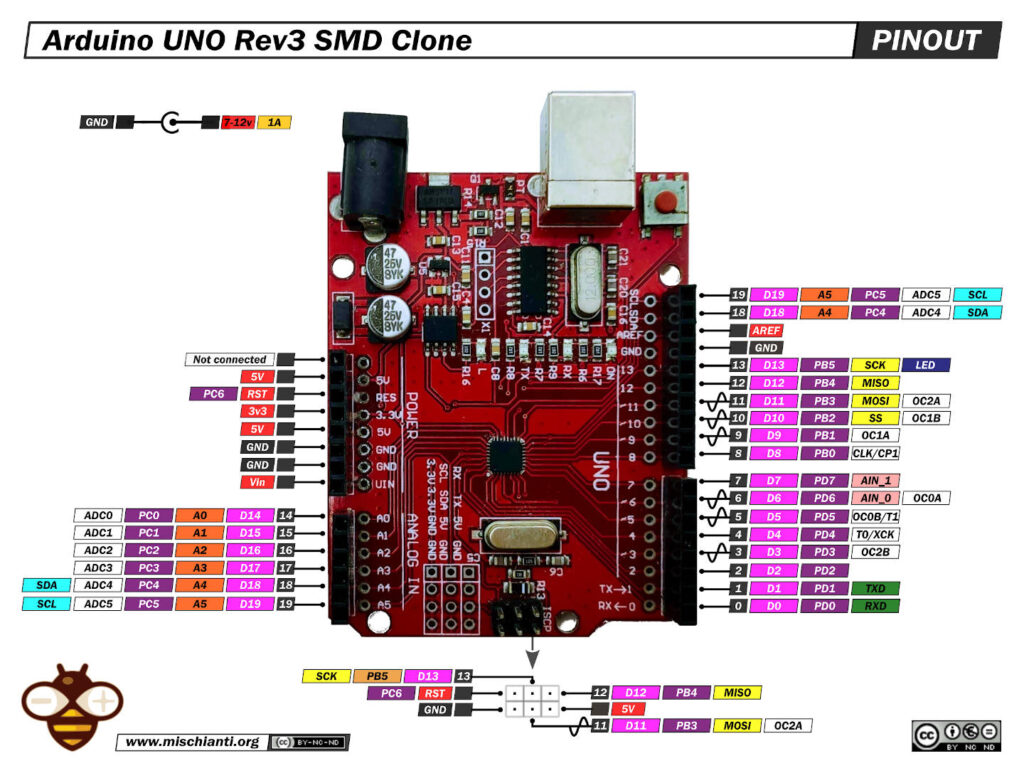Arduino UNO Rev 3 CH340 SMD Clone: high-resolution pinout, datasheet, and specs
The Arduino Uno is a microcontroller board that serves as a fundamental tool for electronics and coding enthusiasts, educators, and professionals in the development of interactive projects. A lot of clones with similar specifications are built from different productions like this.

Link to the high-resolution image
Arduino UNO Rev 3 SMD Clone, the ATmega16U2, which is typically used as the USB-to-serial converter in the original Arduino UNO, is absent. This means that the clone might use a different chip CH340 for USB-to-serial communication. Additionally, the IOREF pin, which is usually present in the original Arduino UNO to indicate the operating voltage, is replaced with a 5V pin in this clone. This alteration could affect compatibility with certain shields or components designed for the standard Arduino UNO.
The Arduino UNO Rev 3 SMD Clone is a microcontroller board similar to the standard Arduino UNO but with some differences, notably in its construction and certain technical aspects. Here are the main features and technical specifications:
Main Features
- Microcontroller: Based on the ATmega328P.
- Digital I/O Pins: 14 pins, with 6 capable of providing PWM output.
- Analog Input Pins: 6 pins.
- Resonator: 16 MHz ceramic resonator.
- Connectivity: USB connection, ICSP header.
- Reset Button: Included.
- EEPROM: 1 KB, non-volatile memory.
- Battery Connector: Barrel plug connector, compatible with a 9V battery.
Technical Specifications
- Built-in LED: Pin 13.
- Communication: Supports UART, I2C, and SPI.
- Power: I/O Voltage of 5V, Input voltage range 7-12V.
- DC Current per I/O Pin: 20 mA.
- Memory: 2KB SRAM, 32KB FLASH.
- Dimensions: Weighs 25 g, with a width of 53.4 mm and a length of 68.6 mm
Key features of Arduino UNO Clone
The Arduino UNO Rev 3 SMD Clone is a modified version of the standard Arduino UNO, featuring several key differences:
- Microcontroller: It’s based on the ATmega328P.
- USB-to-Serial Converter: Unlike the original Arduino UNO, which uses the ATmega16U2, this clone does not have the ATmega16U2 chip for USB-to-serial conversion, implying it might use a CH340 chip for this purpose.
- IOREF Pin Substitution: The IOREF pin found in the original Arduino UNO, which provides the voltage at which the microcontroller is operating, is substituted with a 5V pin that outputs the voltage applied from the external power supply in the clone. This change can impact the compatibility with certain shields or modules. The other 5v pin provides 5 volts from the output of the internal regulator, useful for powering other 5-volt compatible circuits.
The rest of the features, like the number of I/O pins, PWM capabilities, analog inputs, and power specifications, remain similar to the standard Arduino UNO. This clone is typically used in various DIY projects, educational purposes, and prototyping, just like the original Arduino UNO.
Datasheet
Arduino UNO Datasheet
Arduino UNO schematics
Thanks
- Arduino
- esp8285
- esp8266
- ESP32
- DOIT ESP32 DEV KIT v1
- ESP32 DevKitC v4
- ESP32 WeMos LOLIN32
- ESP32 WeMos LOLIN32 Lite
- ESP32 WeMos LOLIN D32
- ESP32-wroom-32
- NodeMCU-32S
- ESP32-S
- ESP32-CAM
- ESP32-2432S028 (Cheap Yellow Display)
- ESP32-2432S032 (Cheap Yellow Display)
- ESP32 s2
- ESP32c3
- ESP32s3
- ESP32c6
- Arduino SAMD
- STM32
- Raspberry Pi










